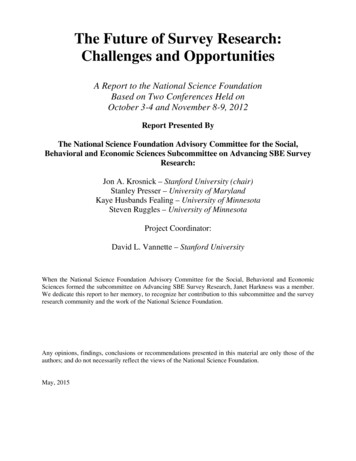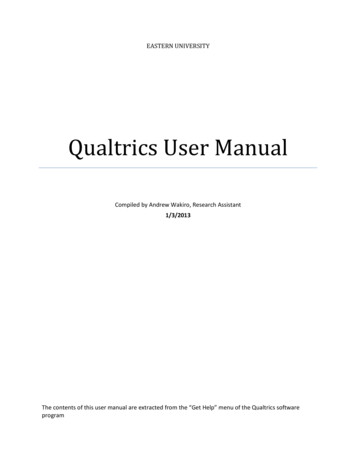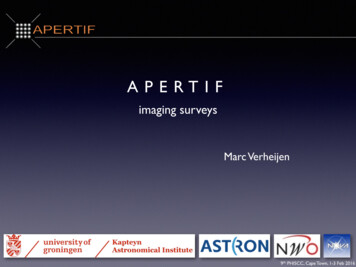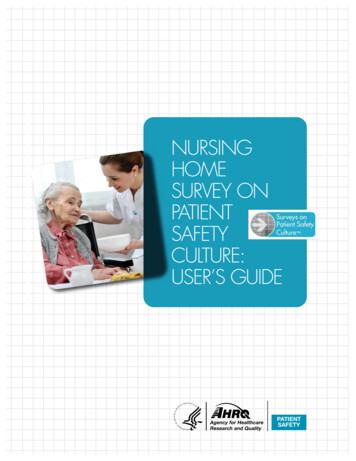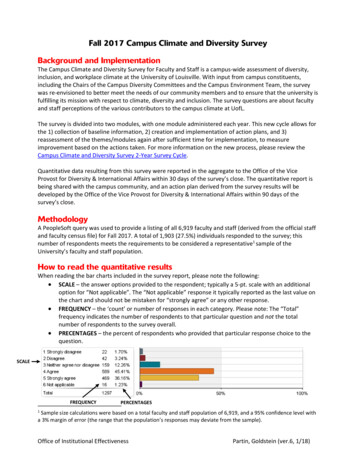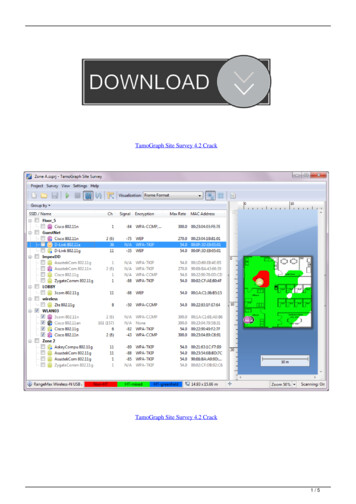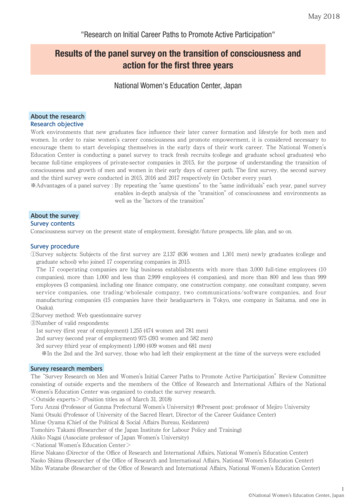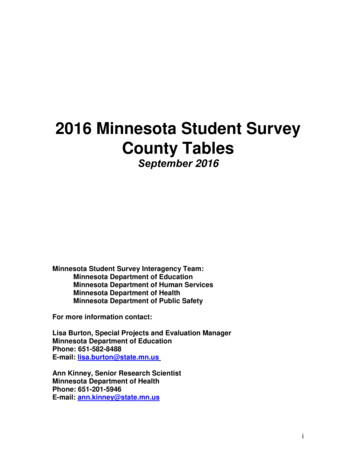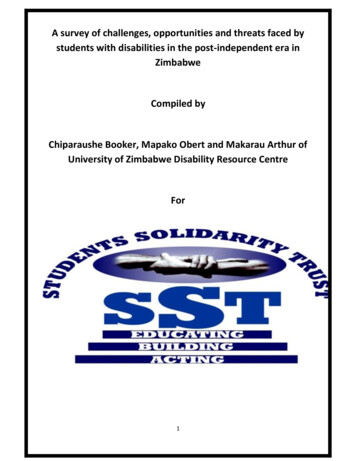
Transcription
A survey of challenges, opportunities and threats faced bystudents with disabilities in the post-independent era inZimbabweCompiled byChiparaushe Booker, Mapako Obert and Makarau Arthur ofUniversity of Zimbabwe Disability Resource CentreFor1
ACKNOWLEDGEMENTSThe Student Solidarity Trust (SST) extends its appreciation to its long time partner, Students andAcademics International Support Fund (SAIH), for its support for this research project and many others.Our sincere gratitude is also extended to our research consultants Booker Chiparaushe, Obert Mapakoand Arthur Makarau of the University of Zimbabwe (UZ) Disability Resource Centre (DRC). We alsoacknowledge the role played by the Permanent Secretary in the Ministry of Higher & Tertiary Educationin granting permission to carry out this study in all Universities, Teachers’ Colleges and TechnicalColleges in Zimbabwe.Cheerful thanks also go to SST staff and in particular Trevor Murai for his field monitoring of theresearch and editorial scrutiny. Lastly our special thanks go to all the respondents who participatedfreely in this study by completing questionnaires and taking part in interviews and focus groupdiscussions.This research was funded by SST. However the findings, interpretations and conclusions expressed inthis report are entirely those of the author(s) and should not be attributed to SST , which does notguarantee their accuracy and can accept no responsibility for any consequences of their use.ABSTRACTThis research was carried out with the main aim of bringing out the challenges, opportunities andthreats faced by students with disabilities and conditions who are enrolled in institutions of highereducation in Zimbabwe. The study covered three provinces namely Harare, Bulawayo and Midlandstargeting all universities, both teachers’ and technical colleges in these respective provinces. To collectdata the researchers used questionnaires, interview schedules and focus group discussions. Thequestionnaires targeted administrators, lecturers and students with disabilities and conditions whileinterviews and focus group discussions were aimed at capturing data from students with disabilities andconditions. The data collected was analyzed using (SPSS) method and the results were presented in formof tables and pie –charts. The population was composed of 103 students with disabilities andconditions, 9 administrators and 11 lecturers which make a total of 123 participants. The sample had 50students with disabilities and conditions, 20 both administrators and lecturers making a total of 70participants.Main findings from the study Inaccessibility of buildings for example lecture theatres or rooms, halls of residence, toilets andtubs thereby disadvantaging greatly those students who are physically challenged; Shortage of equipment and materials for example Perkins Braille machines, Pac-Mates, TapeRecorders, brailed textbooks or reading materials for the visually impaired students; The majority of students with disabilities fall under the category of the visual impaired; Offices of Vice Chancellors, Pro-Vice Chancellors and Registrar in majority of state universitiesare not accessible to students in wheel chairs;2
In all tertiary education institutions the majority if not all lecturers in post have no formaltraining in handling students with disabilities; In natural sciences and technical subjects there is lack and in some institutions un-availability oftrained lecturers to teach students with disabilities; Most institutions of higher learning discourage and or marginalize students with disabilities whointend to pursue natural sciences; At A-level, of which the A-level qualification is used as entrance at universities, fewer disabledstudents who would have passed O-level choose sciences subjects. Additionally disabledstudents generally perform badly in sciences; Donations by well wishers and support by the international community to students withdisabilities have dwindled in the past decade due to Zimbabwe’s sour relations with countries inthe West; There is lack of programmes to sensitize able-bodied students and other college/university staffthat is not directly involved with students with disabilities on the needs and plight of studentswith disabilities; In most tertiary education institutions there are no waiver of tuition fees, no special budgetsand no affirmative action to aid students with disabilities; Study findings reveal that all institutions of higher learning are not mainstreaming HIV and AIDSissues in programmes for students with disabilities. There is lack of peer counseling, lack of HIVand AIDS promotional material available in a format accessible to various categories of studentswith disabilities; Visually impaired students faced mobility problems as information of changes in theenvironment like digging of trenches is not communicated to them, further cars parked inundesignated areas, obstacles such as chairs left on their paths, open doors in corridors presenteveryday challenges in their mobility hence the need for able-bodied students sensitizationprogrammes; Visually impaired students also had challenges accessing communication pasted on noticeboards in print;For students with Albinism their main concern was inability to read lecture notes on chalkboardsduring lectures and also failure to read notices on notice boards due to their short-sightedness.Also these students are not provided with their special skin lotions to protect them from sunburns. On sports the main findings were that there was the lack of specially trained instructorsto cater for students with disabilities and conditions. 3
TABLE OF e of contentsiiiList of tablesivList of figuresCHAPTER ONETHE PROBLEM AND ITS SETTING1.0Introduction11.1Background of the study1.2Statement of the problem1.3Justification of the study1.4Objectives of the study31.5Significance of the study31.6.0Research question31.7.0Definition of key terms1.8.0Delimitations of study5CHAPTER 22.0Literature review2.1Introduction2.1.1What is Disability?2.2.Mainstreaming disability2.2.1Legislation662.2.1.1. United Nations Initiatives62.2.1.2. Disabled Persons Act (DPA) of 199494
2.2.1.5 Disability and Human Rights92.2.1.6 College and University students with disabilities102.2.1.6.1 Institutional Mission102.2.1.6.2 Policy Issues112.2.1.6.3 Disclosure of Disability14CHAPTER 3RESEARCH METHODOLOGY3.0Introduction123.1Research design3.1.2Disadvantages of the descriptive survey 3.5Data collection procedure3.6Data analysis3.7Pilot study3.8Results of Pilot study3.9Summary131819CHAPTER 4DATA ANALYSIS, INTERPRETATION AND DISCUSSION4.0Introduction4.1Questionnaire Responses4.2Administrators’ Responses4.3Interviews20SUMMARY, CONCLUSIONS AND RECOMMENDATIONS5.0Introduction415
S41LIST OF TABLESTablePage4.1.1: Distribution of lecturers at State Universities according to subjects they teach students withdisabilities20Table 4.1.2:Provision of Extra time for students with disabilities’ work by lecturers23Table 4.1.3:Prevalence rate of Trained Teachers23Table 4.2.1:Types of disabilities that the Universities are catering for28Table 4.2.2:Existence of Special Legislation in Institutions’ Charter31Table 4.2.3:Provision of Sports for students with disabilities32Table 4.2.4:Mainstreaming of students with disabilities inHIV and AIDS, Peer Counseling Services32List of Figures6
AcronymsAIDSAcquired Immuno-Deficiency SyndromeAUAfrica UniversityCRPDConvention on Rights of Persons with DisabilitiesDRCDisability Resource CentreDPADisabled Persons ActFGDFocus Group DiscussionsGPAGlobal Political AgreementHIVHuman Immuno-VirusICTInformation and Communication TechnologyILOInternational Labor OrganizationsIYPDMSUMidlands State UniversityNUSTNational University of Science and TechnologySPSSStatistical Package for Social ScientistSSTStudent Solidarity TrustUCEUnited College of EducationUDHRUniversal Declaration of Human RightsMDGsMillennium Development GoalsUNUnited NationsUZUniversity of ZimbabweZOUZimbabwe Open University7
ABOUT SSTIt was born out of the Zimbabwe National Students Union, as a strategic vehicle to deal withpractical solidarity issues for the student’s movement. To date the SST has assisted wellover 95 student activists with continuing their education after being expelled, and at least1248 students who have found themselves in situations where they were being persecutedfor participating in the struggle for the right to education and respect for student andacademic rights. The first 15 student activists to complete their education through theassistance of the SST graduated in 2006, and where honored by the students movement ata ceremony dubbed the “Against All Odds Ceremony” on November 17 2006 in BulawayoSST PROGRAMS1.Students Social Safety Net ProgramThe Students Social Safety Net (SSSN) is a solidarity program that the SST uses to cushionstudent activists and leaders from the effects of politically motivated Victimisation by way ofsuspensions and expulsions. It also aims to act as a capacity building tool for current andfuture leadership through education of those who have shown courage, and exceptionalleadership as activists within the student’s movement, as such ensuring that the mechanicsare in place for continuous churning out of leaders both for the student’s movement, civilsociety but also for the future. It also has a an essential component of the program, TheStudents Rapid Solidarity Support Program (SRSSP) which is an emergency mitigationtool that the SST intends to use as a cover in times of unforeseen crisis with regards toarrests, victimization and other abuses, within the students movement.2.Research and Information ProgramThe Research and Information program seeks to abate the smooth flow of information onactivities, violations and actions within the students movement and carry out research andpolicy analysis on issues pertaining the education sector. The program ensures thecollection, packaging and dissemination of activities that are obtaining within the students’movement, including human rights abuses which are manifested through suspensions,expulsions and arbitrary arrests, while also telling the world the humane stories from withinthe same sector. As function of this program, the SST also tries to ensure that there is astanding crop trained Human rights monitors and reporters in Zimbabwe’s institutions ofhigher learning, who are familiar with effective information packaging which insures thatinjustices are reported on and captured in a bid not only to flag the issues, but also toattempt remedial action and fight against impunity.8
3Regional Solidarity Building and NetworkingThe Regional Solidarity Building (RSBN) Program is a networking initiative that is meant tosensitize primarily the SADC region on the situation in Zimbabwe especially with regards tostudents, and at the same time build relationships for the possibilities of people to peoplesolidarity actions. The program entails establishing relationships with student’s movements,social movements and rights based organisations and watchdogs in the regions.4International Solidarity Building and NetworkingThe International Solidarity Building and Networking (ISBN), is a program that specificallyaims to enhance the possibilities of having international solidarity for the studentsmovement politically victimized students in Zimbabwe. It also specifically aims tointernationalize the crisis in Zimbabwe as it regards students while ensuring internationalrelationships that can be used to ease the burden of extremely victimized student leadersand activist, through offering international safety nets.SST GovernanceThe SST has a 9 member board of trustees which oversees the running of the organisation.The board is made up of young but prominent Human Rights Defenders from differentsectors of Zimbabwean Civil Society where they lead. It is renewed through perpetualsuccession.SST SecretariatThe SST has a staff compliment of 8, which is led by a Programmes Coordinator andregularly takes aboard interns on attachment. The SST has a strong volunteer base throughits fellows (students expelled from local universities now pursuing alternative educationthrough the SST educational programme with UNISA and abroad), who from time to timevolunteer at the organisation for different tasks.Staff Complement9
Masimba Nyamanhindi: Programmes Coordinator, Simba Moyo: Programmes Manager,Marlene Mutsira: Finance and Administration Manager, Trevor Murai: Research andInformation officer, Darlington Madzonga: Social Safety Net Officer, Masimba Kuchera:Programmes Officer (Research and Information), Rachel Matatare: Administrator, GoodmanMimise: Programmes Officer (Fellows Liaison and Resource Centre) and Levyniah Katshana:Intern (Gender and InformationCHAPTER ONEA SURVEY OF CHALLENGES, OPPORTUNITIES AND THREATS FACED BY STUDENTS WITH DISABILITIES INTHE POST-INDEPENDENCE ERA IN ZIMBABWEINTRODUCTIONZimbabwe witnessed a huge expansion in learning institutions that offer certificates, diplomas, degreesand other post-graduate qualifications to students, which also included students with disabilities. Forinstance, at Independence, Zimbabwe had one university but now, there are seven state universities,four church related universities and a women’s university that are fully internationally accredited.(http://www.zimembassy.se/health.html). In many of these institutions research on students withdisabilities in higher education has shown that these students often face additional challenges andthreats in their educational milieu. Paul (2000) note that students with disabilities face both physical andattitudinal barriers within their college or university environments. Rao (2004) states that, ‘attitudinalbarriers’ are recognized widely as an impediment to success of people with disabilities. Unfortunately,this topic happens to be one of the least researched variables in studies done with faculties andstudents with disabilities in higher education (Fonosch and Schwab, 1981).Furthermore, there are a few other studies undertaken since 1981 that studied this factor in relation tosuccess of students with disabilities in higher education. Benham, 1995; Lewis, 1998; McCarthy andCampbell, 1993, 2002; Schoen, Uysal and McDonald, 1987; William, (2000) also expressed the samecontention. The study seeks to examine and expose the challenges, opportunities and threats faced bystudents with disabilities and conditions in Zimbabwe.BACKGROUND OF THE STUDYEducation for students with disabilities in Zimbabwe has undergone a tremendous revolution since1980. The inclusion of students with disabilities has not been taken seriously in Zimbabwe. For instance,The 1987 Education Act, that was amended more than six times now, is silent about the education ofstudents with disabilities. However despite this lack of seriousness in Zimbabwe’s legislative system,students with disabilities have always struggled to access higher and tertiary education in Zimbabwe.Today some Teacher Training, Technical Colleges, and Agricultural Colleges such as Kushinga Phikelela,United College of Education and Bondolfi Teachers’ College, occasionally enroll students withdisabilities. Additionally, some Zimbabwean Universities such as University of Zimbabwe (UZ), AfricaUniversity (AU) National University of Science and Technology (NUST), Zimbabwe Open University (ZOU)and the Midlands State University (MSU), are currently enrolling students with disabilities. This studysought to gather information on challenges, threats and opportunities faced by students with disabilitiesat universities and colleges in Zimbabwe.10
STATEMENT OF THE PROBLEMHigher Education in Zimbabwe has undergone changes in response to modifications in the perceivedneeds of the society, legislative policies and social attitudes. Consequently, the student pool haschanged considerably in higher educational institutions and now includes a significant number ofstudents with disabilities seeking to complete their studies as colleges and universities increases acrossthe country. The students with disabilities and conditions face a number of challenges, threats andopportunities which this study seeks to unveil.JUSTIFICATION OF THE STUDYNo known research in Zimbabwe has managed to determine the challenges, opportunities and threatsthat are faced by students with disabilities in the tertiary or higher education sector in Zimbabwe. Thestudy has exposed specific concerns about the challenges, opportunities and threats faced by studentswith disabilities in the higher education sector in Zimbabwe. The study provides valuable insights intoways of improving the learning environment and opportunities for students with disabilities in highereducation in Zimbabwe.1.4 OBJECTIVES OF THE STUDY1. To establish major challenges faced by students with disabilities and conditions in highereducation institutions;2. To explore the possible opportunities in higher education that are an advantage to theeducation of students with disabilities and conditions;3. To expose the threats which students with disabilities experience in their studies in highereducation institutions.1.5 SIGNIFICANCE OF THE STUDYThis study is aimed at highlighting the major problems which students with disabilities and conditionsare encountering in pursuance of their higher education institutions in Zimbabwe. The research findingsbrought out clearly the challenges, opportunities and threats of each specific disability or conditionunder study.The information gathered is vital to policy makers, stake holders, donors, service providers, andadministrators, civil society organizations and the general public in the provision of interventionstrategies to address the plight of students with disabilities and conditions. The study added newinformation and also opened new avenues for further research in the education of students withdisabilities.1.6.0 RESEARCH QUESTION1.6.1 Main question:11
What are the challenges, opportunities and threats faced by students with disabilities in the highereducational institutions in Zimbabwe?1.6.2 Sub questions:1. What are the effects of stigmatization on people with disabilities and conditions?2. What are the social challenges experienced by students with disabilities and conditions inZimbabwe?3. What are the policy issues in relation to the students with disabilities and conditions in tertiaryeducation in Zimbabwe?4. What literature surrounds the understanding, and provision of support services for studentswith disabilities in Zimbabwe?1.7.0 DEFINITION OF KEY TERMS1.7.1 Physical Impairment:Include impairment of upper limb(s), lower limb(s) manual dexterity, and disability in coordination withdifferent organs of the body. Often cause a person to use special equipment like a wheel chair, cane, orprosthetic limb. Persons with physical disabilities may have difficulties with movement or self es/)1.7.2 Visual impairment:This includes blindness and ocular trauma. Some of the visual impairment include scratched cornea,scratches on the sclera, diabetic-related eye conditions, dry eyes, and corneal es/).1.7.3 Hearing Impairment:This includes people who are completely or partially deaf. People who are partially deaf can often usehearing aids to assist their hearing. Deafness can be evident at birth, or later in life from severalbiological causes. For example Meningitis can damage the auditory nerve or cochlea. Deaf people usesign language as means of disabilities.php)1.7.4 Albinism:An inherited condition that is present at birth. It is characterized by lack of the usual amount of pigmentmelanin, which is the substance that gives colour to the skin, hair and eyes. Albinism always affectsvision and may ultimately lead to skin cancer. The genes that cause albinism also cause abnormaldevelopments of the nerve connections between the eyes and the brain. Most people with albinism are12
born to parents without the condition but both parents must carry a copy of the defective gene andboth must pass on that copy to their child. (http://www.answers.com/topic/albinism).1.7.5 Invisible/ health-related disability:The Invisible/health related disability refers to any medical condition which includes sicknesses ordiseases such as epilepsy, diabetes, cancer. Another invisible disability is psychiatric disabilitycharacterized by disorders of mood or feeling states either short or long term. This category includesconditions like bipolar disorder and depression among others. 7.6 DELIMITATIONS OF STUDYThe study focuses on challenges, opportunities and threats which students with disabilities andconditions experience in tertiary education institutions in Bulawayo, Gweru and Harare.13
CHAPTER 2LITERATURE REVIEW2.1 INTRODUCTIONThis Chapter will review related literature on students with disabilities in higher education done by otherresearchers. Also the rights of people with disabilities will be discussed. The literature will be reviewedunder the following subheadings: What is disability, mainstreaming disability through Legislation,policies, practices on making environments to accommodate people with disabilities.2.1 What is Disability?There is no universal agreed definition of disability. Historically disability was seen primarily as amedical condition, with the problem located within the individual. This medical or individual model waschallenged by disability activists who re-conceptualized disability as primarily a social phenomenon. Thesocial model of disability draws a clear distinction between impairments and disability. Society disablespeople with impairments by its failure to recognize and accommodate difference and through theattitudinal environmental and institutional barriers it erects towards people with impairments.Disability thus arises from a complex interaction between health conditions and the context in whichthey exist. Disability is a relative term with certain impairments becoming more or less disabling indifferent contexts.2.2. United Nations InitiativesAlthough the human rights charter promulgated in 1948 and its subsequent versions clearly indicatedthat its provisions are meant for all human beings the unique circumstances of persons with disabilitieshave in the last thirty years called for special focus.A number of important UN instruments have been developed to reflect the growing understanding ofthe special circumstances. The first was the 1971 UN Declaration on the Rights of the MentallyHandicapped, which called for the recognition of people with mental disabilities as human beings. Itcalls upon the world community to consider them all the entitlements of other human beings. Itspecifies concerns unique to the mentally handicapped and gives guidelines on how to address them.The Declaration set pace for more activities at UN level in respect to other disabilities.The 1975 UN Declaration on the Rights of Persons with Disabilities expanded the space for persons withdisabilities must be accorded respects, opportunity for rehabilitation, education, employment, humandignity and enjoyment of life within a family set up.14
The Global awareness created during the UN IYDP in 1981 expanded social participation and equality fordisabled persons. This was followed by the 1982 to 1992 UN Decade for Persons with Disabilities. Toensure the decade had the desired impact, a comprehensive document entitled Word Programme ofAction Concerning Disabled Persons was developed and adopted through a UN resolution in 1982. Thedocument provided guidelines on effective measures for the realization of full participation of personswith disabilities in social life, development and equality. UN agencies were encouraged to globallyimplement the document in accordance with their areas of specialization.The International Labour Organization (ILO) formulated the first ever enforceable documents to itsmembers. The Vocational Rehabilitation and Employment (Disabled Persons) Convention of 1983ensures that the appropriate vocational rehabilitation measures are made available to all categories ofdisabled persons. It also promotes the employment of disabled persons in the open labour markets.The UN Standard Rules on Equalization on Opportunities for Persons with Disabilities stipulated twenty– two rules on the behaviour of states. The rules were divided into four categories. The first categoryincluded four rules, which addressed preconditions for equalization of opportunities. These includeawareness raising, medical care and rehabilitation and support services. The second and mostimportant covered rules are 12 on target areas of equalization of opportunities. These are accessibility,education, employment, income maintenance social security, family life and personal integrity, culture,religion, recreation and sports. The last 10 rules were on measures of implementation and mechanismfor monitoring. The document was presented to the UN Assembly and adopted in December 1993.Seven years after adoption of the UN Standard Rules it became clear that goodwill was not enough tochange the lives of persons with disabilities. More pressure through enforceable instruments wasrequired to impact heavily on countries to provide a fovourable social environment. Efforts to increasecooperation, integration and awareness on disability issues by governments and relevant organizationsremained insufficient in promoting full and reflective participation and equal opportunities for personswith disabilities in economic, social, cultural and political life. There was still need for a morecomprehensive and binding instrument to promote and protect the rights and dignity of persons withdisability.The United Nations International Convention on the Rights of people with Disabilities (CRPD) istherefore a product of five years of work by the United Nations Ad Hoc committee which includedamong others, member states and the disability organizations. The CRPD is guided by the followingprinciples: Respect for inherent dignity, individual autonomy including the freedom to make one’s ownchoices and independence of persons;Non – discrimination;Full and effective participation and inclusion in society;Respect for difference and acceptance of persons with disabilities as part of human dignity andhumanity;Equality of opportunity;Accessibility;Equality between men and women and15
Respect for the evolving capacities of children with disabilities to preserve their identities.Countries that fall under the Convention commit themselves to develop and carry out policies, laws andadministrative measures for securing the rights recognized in the convention and abolish laws,regulations, customs and practices that constitute discrimination (Article 4).On the fundamental issue of accessibility (Article 9), the convention requires countries to identify andeliminate obstacles and barriers, and ensure that persons with disabilities can access their environment,transportation and public services.Personal mobility and the greatest possible independence are to be fostered by facility affordablepersonal mobility, training in mobility skills and access to mobility aids, device assistive technologies andlive assistance (Article 20)States are to ensure equal access to education, vocational training, adult education and lifelong learning.Education is to employ the appropriate materials, educational technologies and forms ofcommunication. Pupils with sport needs are to receive support measures and pupils who are blind, deafand dump are to receive their education in the most appropriate modes of communication fromteachers who are qualified in sign language and Braille Education of persons with disabilities must fostertheir participation in society their sense of dignity and self worth and the development of theirpotential, personality, creativity and ability (Article 24).Disability is not specifically mentioned in the Millennium Developmental Goals (MDGs), but persons withdisabilities are implicitly included.2. Disabled Persons Act DPA (Chapter 17:01) of 1992Disabled people in Zimbabwe are protected by the DPA of 1992 which prohibits “discrimination againstdisabled in relation to opportunities.The Amended Constitution of Zimbabwe 2005 Section 23 also provides against discrimination on thegrounds of race, sex, gender or physical disability.2.2.1.3 Disability and Human RightsHuman rights and fundamental freedoms are the birth rights of all. This is stated in the UniversalDeclaration of Human Rights (UDHR) and finds specific application in the International Covenant on Civiland Political Rights, the International Covenant on Economic, Social and Cultural Rights and otherInternational instruments. States have affirmed this principle again and again, including in theCopenhagen Declaration acknowledging that the promotion and protection of these rights andfreedoms is primarily the responsibility of governments.The right to development is an inalienable human right by virtue of which every human person and allpeoples are entitled to participate in, contribute and enjoy economic, social and cultural and politicaldevelopment in which all human rights and fundamental freedoms can be fully realized. Because allhuman rights are sacrosanct and none is superior to another while development facilities the enjoymentof all human rights, the lack of development may not be invoked to justify the abridgement of16
international cooperation in the eradication of poverty and promotion of development is apparent. Theprinciple of international cooperation has bee
1 A survey of challenges, opportunities and threats faced by students with disabilities in the post-independent era in Zimbabwe Compiled by Chiparaushe Booker, Mapako Obert and Makarau Arthur of


